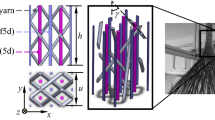Abstract
This paper first presents an analytical model for a new kind of braided composite called 3D surface-core 4-directional braided composite. Taking into account the braiding process, three types of microstructural unit-cell models are established with respect to the interior, surface, and corner regions. According to the spatial paths and squeezing deformation of yarns in the material, different braiding angles and cross-section shapes are adopted. By using the volume averaging method, the total stiffness is calculated and the engineering elastic constants are obtained. The effect of braiding angle and fiber volume fraction on the stiffness is addressed. The theoretical predictions are in good agreement with the experimental data. The effects of edge cuttings on the longitudinal tensile properties of the new material and 3D 4-directional braided composites are experimentally compared. The proposed structure has obvious advantage to restrain the degradation of mechanical properties caused by cuttings.
















Similar content being viewed by others
References
Yu XG, Cui JZ (2007) The prediction on mechanical properties of 4-step braided composites via two-scale method. Compos Sci Technol 67:471–480
Mouritz AP, Bannister MK, Falzon PJ, Leong KH (1999) Review of applications for advanced three-dimensional fibre textile composites. Compos Part A 30:1445–1461
Dong JW, Feng ML (2010) Damage simulation for 3D braided composites by homogenization method. Chin J Aeronaut 23:677–685
Tan P, Tong L, Steven GP (1997) Modelling for predicting the mechanical properties of textile composites—a review. Compos Part A 28:903–922
Li DS, Lu ZX, Jiang N, Fang DN (2011) High strain rate behavior and failure mechanism of three-dimensional five-directional carbon/phenolic braided composites under transverse compression. Compos Part B 42:309–317
Li DS, Li JL, Chen L, Lu ZX, Fang DN (2010) Finite element analysis of mechanical properties of 3D four-directional rectangular braided composites part 1: microgeometry and 3D finite element model. Appl Compos Mater 17:373–387
Li DS, Fang DN, Lu ZX, Yang ZY, Jiang N (2010) Finite element analysis of mechanical properties of 3D four-directional rectangular braided composites—Part 2: validation of the 3D finite element model. Appl Compos Mater 17:389–404
Boualem N, Sereir Z (2011) Accelerated aging of unidirectional hybrid composites under the long-term elevated temperature and moisture concentration. Theor Appl Fract Mech 55:68–75
Mouritz AP, Cox BN (2010) A mechanistic interpretation of the comparative in-plane mechanical properties of 3D woven, stitched and pinned composites. Compos Part A 41:709–728
Mahmood A, Wang XW, Zhou CW (2011) Modeling strategies of 3D woven composites: a review. Compos Struct 93:1947–1963
Macander AB, Crane RM, Camponeschi ET (1986) Fabrication and mechnical properties multidimensionally (X-D) braided composite materials. In: Whitney JM (ed) Composite materials: testing and design (7th conference). [C] STP, vol 893. American Society for testing and materials, Philadelphia, p 422–443
Sun HY, Wu CC (1997) Experimental research on mechanical properties of composite materials with textile structure. J Exp Mech 12:335–341 (in Chinese)
Jiao YN, Li JL, Wei LM, Sun Y (2006) Influence of damage style on tensile and compressive properties of three-dimensional braided composites. Acta Mater Compos Sin 23:52–56 (in Chinese)
Chen L, Tao XM, Choy CL (1999) On the microstructure of three-dimensional braided preforms. Compos Sci Technol 59:391–404
Huang ZM (2004) A bridging model prediction of the ultimate strength of composite laminates subjected to biaxial loads. Compos Sci Technol 64:395–448
Chen D, Sun Y, Ma ZJ, Chen L (2007) Microstructure analysis on elastic behavior of 3D 4-directional braided composites. J Tianjin Polytech Univ 26:6–9 (in Chinese)
Acknowledgements
The work was partially supported by the National Natural Science Foundation of China (No. 11272147), the State Key Laboratory Program (0214G02), and the Priority Academic Program Development of Jiangsu Higher Education Institutions.
Author information
Authors and Affiliations
Corresponding author
Rights and permissions
About this article
Cite this article
Sun, J., Zhou, G. & Zhou, C. Microstructure and mechanical properties of 3D surface-core 4-directional braided composites. J Mater Sci 50, 7398–7412 (2015). https://doi.org/10.1007/s10853-015-9297-1
Received:
Accepted:
Published:
Issue Date:
DOI: https://doi.org/10.1007/s10853-015-9297-1




